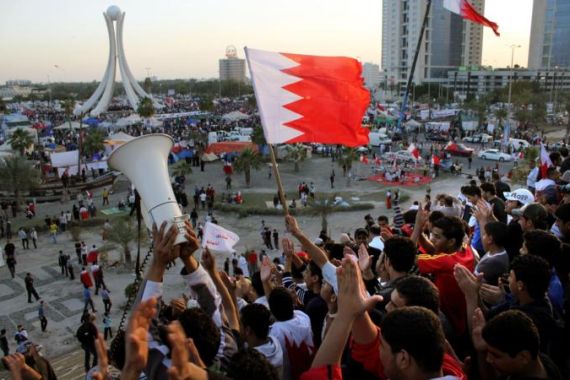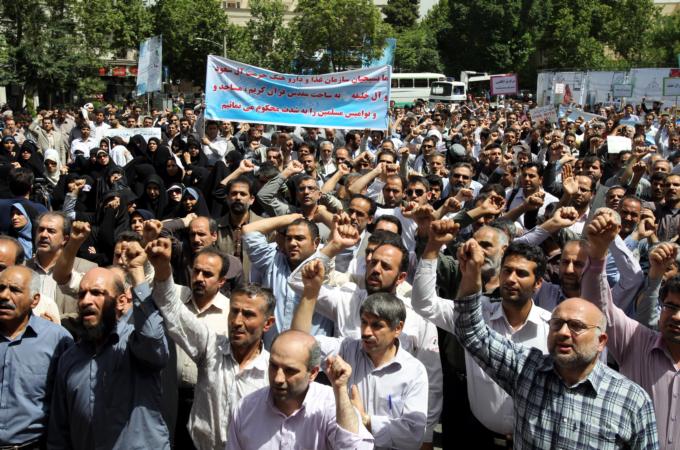The role of the Islamic Republic in Bahrain
Iran’s influence in Bahrain has nothing to do with sparking democratic uprising – but with the repression of revolution.

 |
| The Iranian government has allowed people in Tehran to protest in support of the democratic uprising in Bahrain, on the other hand, it has supressed protests which call for change within the Islamic Republic [EPA] |
Much has been made of the link between the Islamic Republic of Iran and the Shia of Bahrain. Both the ruling regime in Bahrain and the Saudi invading force – leading the Gulf Cooperation Council (GCC) to keep the ruling elite in power – accuse the Islamic Republic of fomenting revolt in the tiny but strategically significant Bahrain. “The Sunni royal family in Saudi Arabia,” according to Britain’s Daily Telegraph, “fears the growing influence of Shiite Iran in the Middle East, and is helping Bahrain’s Sunni rulers retain power.” The clerical rulers of the Islamic Republic deny any involvement. The same Telegraph report indicates that “the [UK] Ministry of Defence has now admitted that members of the Saudi Arabian National Guard sent into Bahrain may have received military training from the British Armed Forces in Saudi Arabia”.
In the crossfire between these charges – the Bahraini ruling regime accusing the Islamic Republic of interference and support for the democratic uprising in their country, while the British army is in fact training the Saudis to go and crush that very uprising, Bahraini democracy activists are being brutally suppressed. “After severely curbing news coverage of its crackdown on opposition groups by foreign reporters,” reported Roy Gutman of the Miami Herald from Dubai, on 25 May 2011. “Bahraini authorities have begun an assault on local journalists working for international news agencies – with arrests, beatings and, apparently in one instance, electric shock.”
Clearing through all the hypocrisies and duplicities that cloud the vision, the influence of the Islamic Republic in Bahrain is not what the ruling regimes in Bahrain and Saudi Arabia, and their supporters in London and Washington DC, wish you to believe: That the ruling clergy in Iran is supporting the democratic uprising in Bahrain. That would be very odd indeed. Why would the Islamic Republic help a democratic uprising in Bahrain, while viciously suppressing one of their own? Just because the protestors in Bahrain happy to be Shia? That would be the bizarrest thing ever.
All these protestations notwithstanding, the Islamic Republic and Bahrain are in fact identical – not just in the majority of their population being Shia but in being ruled by two identically brutal and intolerant dictatorships. The Islamic Republic is frightened out of its wits by the Arab Spring, especially on its own back door, in Bahrain: for the more this Spring blooms and flowers the more it exposes the criminal atrocities of the Islamic Republic over the past thirty years, including, most recently, its own homegrown Green Movement – which one might in fact consider an early blooming of the Arab Spring.
Hijacking revolution
The Arab Spring is the return of the Islamic Republic’s repressed; the exposing of the universal euphoria more than thirty years ago in the magnificent Iranian Revolution of 1977-1979 – which the militant clergy hijacked and turned into a vindictive theocracy. So, yes the Islamic Republic does indeed have a direct influence in Bahrain – but not on the massive democratic uprising in the tiny archipelago, home of the US Fifth Fleet. It is this geo-strategic military asset which makes “the great advocate of democracy” turn a blind eye to the murderous regime in Bahrain, while the UK is in fact training the Saudi military how to crack down on the uprising. The influence of the Islamic Republic in Bahrain is on the ruling regime: teaching it, by example, how viciously to quell a democratic revolt.
By way of yet another distraction, by which stratagem it has managed to stay in power over the past thirty years, the custodians of the sacred terror in the Islamic Republic had dispatched two ships, as reported by Al Jazeera, to Bahrain in order to put up a show of solidarity with the brutalised people of Bahrain. But the assumption that this is a sign of support for the Bahraini Shia is completely flawed. The Islamic Republic mercilessly represses its own Shia population – why would it care for the Shia population of another country?
In a revealing piece in The Independent, Patrick Cockburn reported the atrocities that the ruling regime in Bahrain is committing to murder its own citizens, identifying the victims as Shia. The government says the Shia were working on behalf of the Islamic Republic, dissociating their democratic will from the rest of the Arab uprising.
“The repression,” Patrick Cockburn reports, “is across the board. Sometimes the masked security men who raid Shia villages at night also bulldoze Shia mosques and religious meeting places. At least 27 of these have so far been wrecked or destroyed, while anti-Shia and pro-government graffiti is often sprayed on any walls that survive.” He further reports, “Nurses and doctors in a health system largely run by Shias have been beaten and arrested for treating protesters. Teachers and students are being detained. Some 1,000 professional people have been sacked and have lost their pensions. The one opposition newspaper has been closed. Bahraini students who joined protests abroad have had their funding withdrawn.”
Learning from Iran
These and other atrocities committed by the ruling regime in Bahrain are straight out of the handbook of the Islamic Republic, crushing its own overwhelmingly Shia opposition, its own citizens – men and women, young and old, religious or not. Are Mir Hossein Mousavi and Mahdi Karroubi, two of the principal founders of the Islamic Republic and now the leaders of the Green Movement – now incommunicado and under house arrest – not Shia? Were Neda Agha Sultan, Sohrab A’rabi, Amir Javadifar and scores of other innocent demonstrators, cold-bloodedly murdered by the security forces of the Islamic Republic, not Shia?
Young men and women, peacefully exercising their constitutional rights under the very constitution of the Islamic Republic, in peaceful demonstrations, have been arbitrarily arrested, tortured, and murdered while in custody. They were all Shia. All major human rights organisations have widely reported systematic torture of (Shia – if that is how we are to identify the citizens of a republic) protestors in the dungeons of the Islamic Republic. Mahdi Karroubi, one of the revolutionary founders of the Islamic Republic and a former Speaker of the Parliament, has reported of the widespread rape of young Shia men and women in the same torture chambers.
Why would the Islamic Republic, doing this to its own Shia citizens, care more about the Shia population of Bahrain? The ruling regime in the Islamic Republic is indeed a role model for the rulers of Bahrain and all other repressive regimes as to how brutally to repress a democratic uprising – not how to launch them.
The democratic uprising in Bahrain is integral to the rest of Arab Spring – and the Arab Spring is identical in its aspirations and demands to the Green Movement in Iran. Neither a Sunni-Shia divide in Bahrain nor a Muslim-Christian divide in Egypt mars these dramatic unfolding in the Arab world and beyond. From identical economic malaise, social anomie, political stalemates, and cultural alienation, these social uprisings extend into the two continents – Asia and Africa, and now even into Europe, as perfectly evident from Greece to Spain. These uprisings have nothing to do with the Sunni-Shia, Christian-Muslim, religious-secular divides.
The ‘Shia factor’
It is imperative to remember how was this supposition of the Shia factor entered in the current geopolitics of the region. It was soon after the US-led invasion and occupation of Iraq, when tens of thousands of innocent Iraqi civilians were murdered, and millions became refugees in and out of their own homeland – indeed the wholesale destruction of the entire infrastructure of a sovereign nation-state – that such some US military strategists began to distract attention from the principal culprit responsible for those atrocities and introduced the idea of the Sunni-Shia conflict as the principal problem. These military strategists, employed by the US army, began to offer the pernicious idea that much of the violence in Iraq had to do with the Sunni-Shia divide, and that it was the sign of an emerging geopolitics spearheaded by the Islamic Republic and Saudi Arabia for regional dominance. It was also at this time that the King Abdullah II of Jordan spoke of a “Shia Crescent” as a threat to the stability of the region.
Whether initiated by US military strategists to distract attention from the inflicted pain on the national sovereignty of Iraq and the Iraqis, or imagined by historically outdated Arab rulers afraid of their own people, the fact is that as perfectly evident from one end of the Arab world to another, Shias or Sunni, Muslim or Christian, religious or not, Asians or Africans – or now even Europeans – have now all revolted against identical sets of economically dysfunctional and politically alienating circumstances. People in Spain are now coming out and calling for their own Tahrir Square. Are they also Shia? Iran and Iraq – two Shia nations – were at each other’s throat for eight bloody years (1980-1988), killing hundreds of thousands between them. The Sunni-Shia factor, the favorite schism of US military strategists and the ruling regimes in Bahrain and Saudi Arabia, is a red herring.
Bahrain exposes two identical hypocrisies of the United States and the Islamic Republic. The US ignores the atrocities in Bahrain and the British advisors train the Saudi military to suppress the uprising – while they go to war in Libya; at the same time, the Islamic Republic pretends that it cares for the Shia of Bahrain, while brutalising its own Shia population, and dismisses the Syrian uprising as a plot by the US, Israel, and Saudi Arabia. The fact, staring the whole world in the eyes, is that Iranians, Bahrainis, Syrians, Libyans, and the rest of the region are identical in their transnational uprisings against identically brutal and corrupt powers.
The abuse of the Shia-Sunni divide also points yet again not just to the false sectarianism that seeks to discredit these democratic uprisings but also to the banal racialisation of these transnational, revolutionary movements that cross all such colonially manufactured hostilities. The fact remains that the Arab Spring cannot turn a blind eye to the brutalities of the Islamic Republic just because the US is its enemy. It is imperative that the criminal atrocities of the Islamic Republic be brought fully into the opening picture of the Arab Spring.
The Arab Spring will not fully blossom unless and until the green pastures of Iran are included in it. Labour unions, women’s rights movements and student organisations are identical in their demands and aspirations for their civil liberties in both Iran and the Arab world. Enduring thirty years of a corrupt theocracy has given Iranians much to teach their Arab counterparts; these magnificent revolutionary uprisings from one end of the Arab world to the other has already galvanised the Green Movement in Iran. As the tyrannous regimes in both Bahrain and the Islamic Republic earn from each other how to suppress democratic uprisings, these democratic uprisings must also learn from each other how to topple their corrupt leadership – for in whatever language you learn it: al-Sha’b yurid isqat al-Nizam!
Hamid Dabashi is Hagop Kevorkian Professor of Iranian Studies and Comparative Literature at Columbia University in New York. He is the author, most recently, of Iran, the Green Movement, and the US: The Fox and the Paradox (Zed, 2010).
The views expressed in this article are the author’s own and do not necessarily reflect Al Jazeera’s editorial policy.
